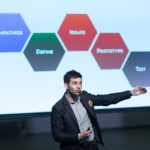Contemporary education
Collaborative platforms among students, design thinking, mentoring…. Technology is changing educational models.

Three years ago, Jordi Llonch lived in Vienna and was a commercial airline pilot. Today he lives in Barcelona, has abandoned the airline business and is the CEO of the Sharing Academy, the collaborative platform for private classes for college students.
The 31 year old Catalan entrepreneur got the idea of creating a platform that allows students to find and offer private classes among colleagues studying for the same degree when he started to combine his job as a pilot with multimedia engineering classes. “I couldn’t manage to pass a single class and I got desperate. I didn’t have time to look at the school bulletin board and wasn’t able to get in touch with people who could explain me the materials online.”
“There is no one better to help you than a classmate who has suffered through the same thing
Llonch used his final project to create a platform where college students could become teachers to help other students. “There is no one better to help you than a classmate who has suffered through the same thing,” says Llonch. He explains that the Sharing Academy verifies the identify and grades of those who want to teach classes, and stresses the importance of contacting someone from the same university to explain difficult classes.

Jordi Llonch, CEO de Sharing Academy
His platform, which received one of five awards in the Telefónica Foundation’s Top 100 Educational Innovations 2016 report, has been used by 6,500 students in 53 universities in its year and a half of existence.
This former pilot’s successful idea is an example of how innovation is revolutionizing education in today’s digital society. And it’s not changing for just students.
Mentoring and design thinking
Janet Gless, from the U.S., presented another disruptive project that aims to address the high drop-out rate among teachers - over 50% in some rural areas of the U.S. She developed a mentoring model so that teachers can receive support starting on the first day of class.
New Teacher Center is a program that trains mentors and which relies on design thinking and data of all kinds – attendance, leaves, schedule analysis, grades, incidents, etc. It’s an evidence-based model that creates standards when something works well.
It’s necessary to foster creativity
“We assess what teachers need. They can talk to experts in a safe environment and thanks to the data, we can monitor how they’re doing, which is key,” stresses Gless. She adds that students also benefit from the mentoring program, which has been implemented in 34 states. The program has impacted nearly 1.5 million students, who tend to get better grades with motivated teachers.

Ariel Raz, experience designer de K12 Lab Network
Design thinking is also used by another award-winning project, K12LabNetwork, to motivate students and teachers. The model was developed by d.school, Stanford University’s Institute of Design.
“We encourage empathy. We want to shorten the time it takes to improve schools and for ideas from experiences to be incorporated. It’s necessary to foster creativity,” explains the project’s spokesperson Ariel Raz. The U.S. citizen explains how different U.S. schools have convinced school leadership to follow a student all day. This lets them put themselves in the shoes of the student and become aware of the “user experience” for the first time.
Bringing the Maker Movement into the classroom so that students can create prototypes with their own hands; programs to teach robotics and programming like the one developed by Google and Ayuda en Acción, which seeks to reduce the digital and gender gap, are other examples of the changes underway in educational models. Another sector witnessing how technology is shaking its foundations.
*If you are interested in this subject, connect with BBVA at LinkedIn to get related information